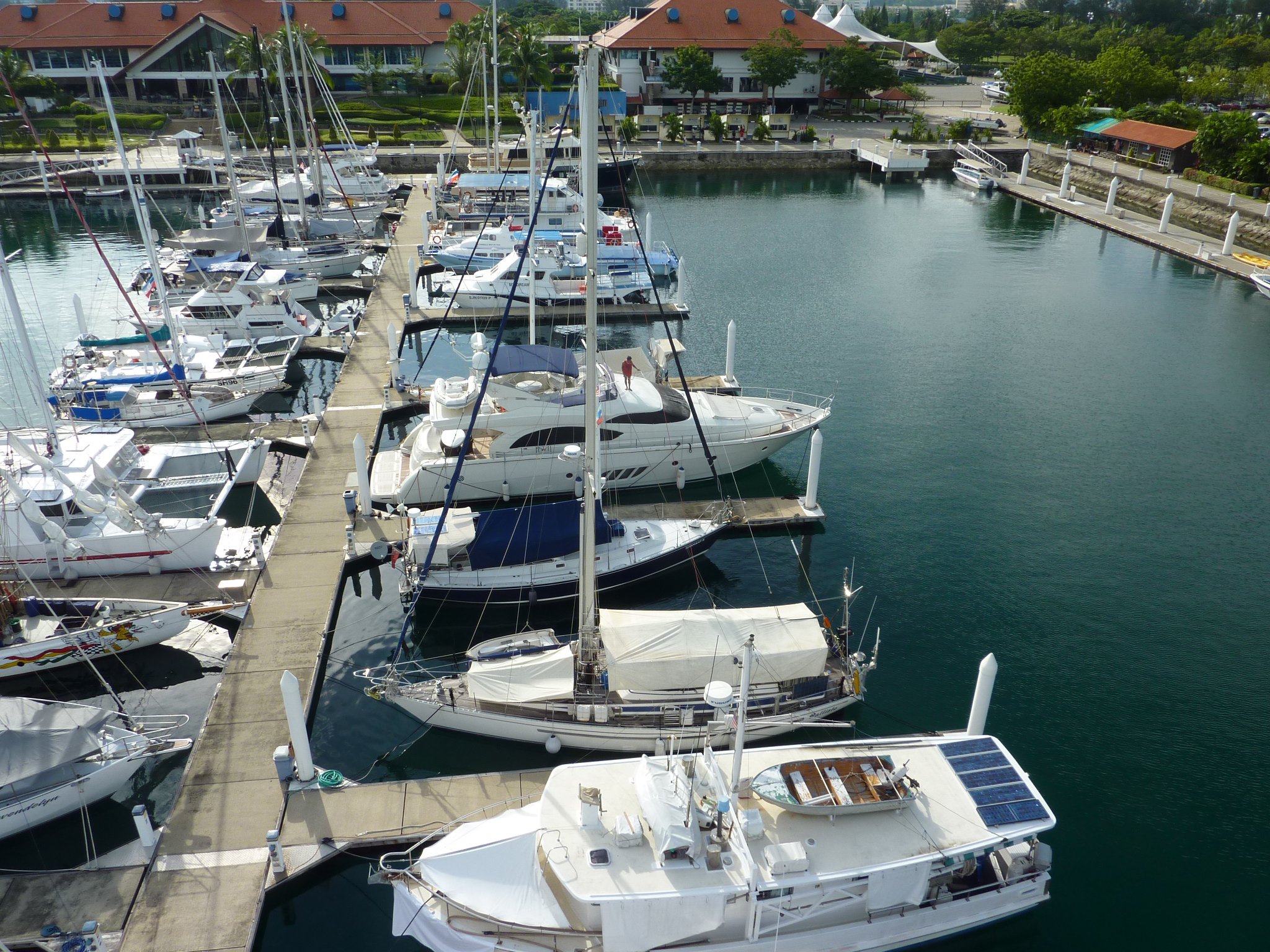

I think the expression is “OMG!! Have I been here that long?” Nearly six years! Based in a luxurious marina aboard a boat Philip and I designed to be self sufficient away from civilisation........
Living in Sutera Harbour is a bit like living in Disneyland. The marina is surrounded by two attached resorts and has a marina club like none you have ever seen before. Two pools, two restaurants, reading and snooker rooms, squash and tennis and badminton courts, a gym, sauna, spa and a movie theatre. Hell, it even has its own bowling alley! And all walking distance to town (but who walks when you can take the air conditioned shuttle bus.)
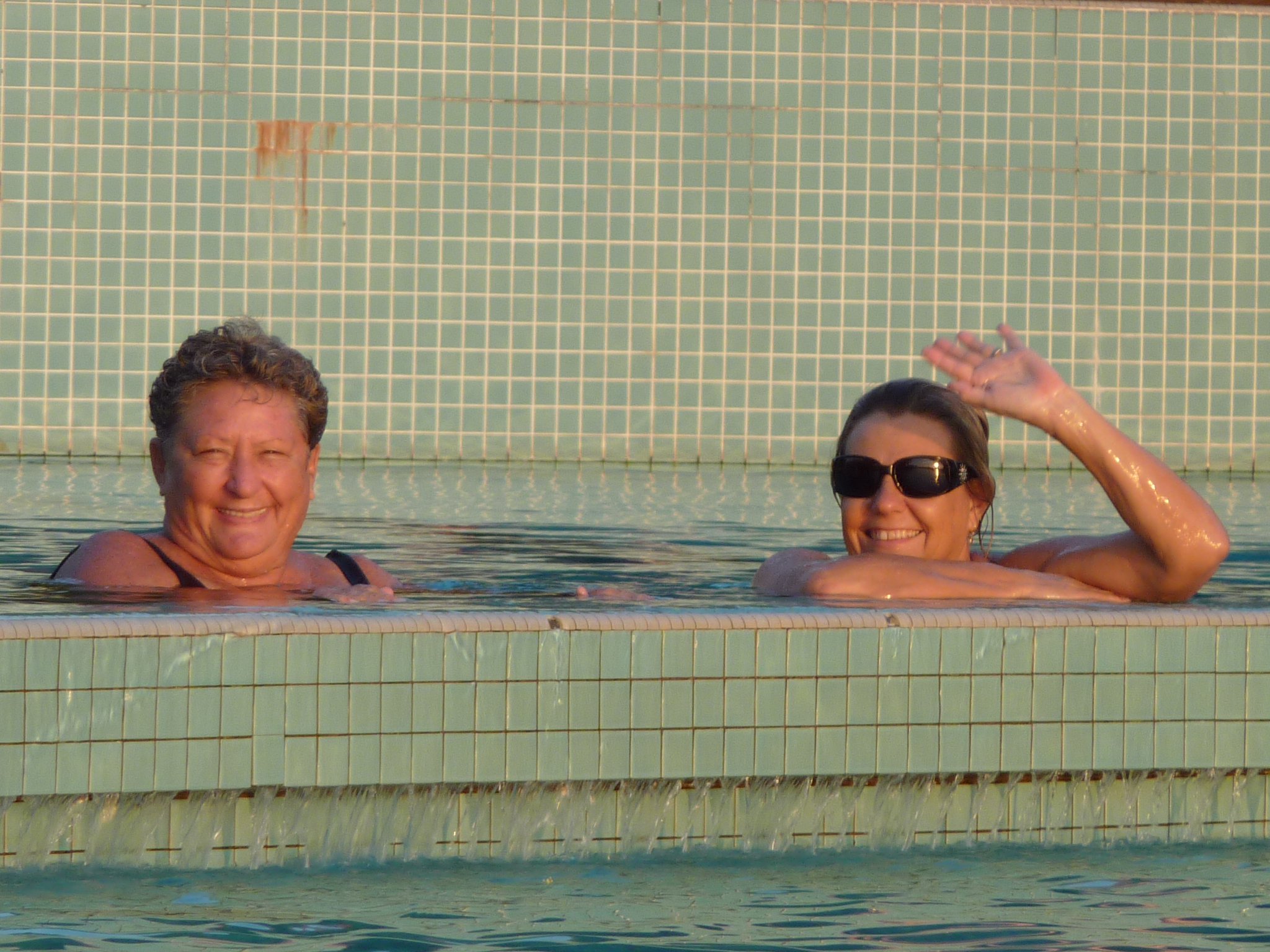


.jpg)
Since Philip died at the end of 2008 I have been living on Lifeline more or less as a “one bedroom apartment on water”. I get to wave at the boats heading out to the islands as I sit on my back deck with my morning coffee.
Luckily for me, when our clever electrical engineer friend, Leon, designed and installed our electrical system, he made it so that I only have to plug in my electrical lead and flip a switch to have shore power. All my 240v Australian style wall plugs work the same whether on inverter power or shore power. I'm also glad of the neat, logical, LABELLED!!! switchboard that lets me know when I've turned the fridge off or which fuse has flipped when I've run the jug, the toaster, the microwave and the coffee machine all at the same time.
Apart from a two week cruise to the islands at the tip of Borneo in 2010 with a fellow boating widow, 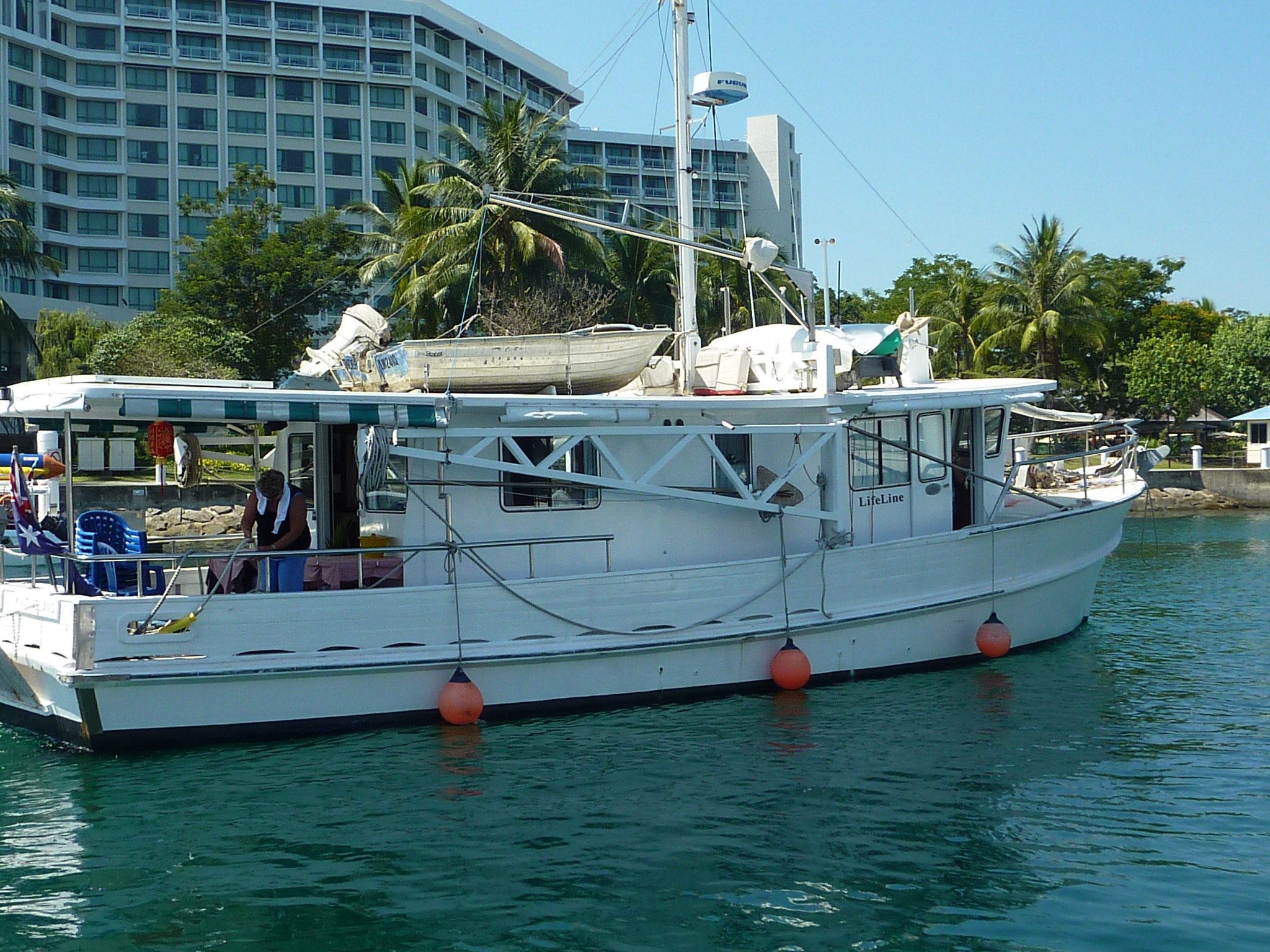 and a couple of picnics to the islands less than a couple of kilometres from the harbour, poor old Lifeline doesn’t get out much. But every year, around April/May, my boat carpenter, Juhan, and his helper join me for the 200nm round trip up to Kudat to haul out.
and a couple of picnics to the islands less than a couple of kilometres from the harbour, poor old Lifeline doesn’t get out much. But every year, around April/May, my boat carpenter, Juhan, and his helper join me for the 200nm round trip up to Kudat to haul out.
One of the things I realised very quickly after Philip died, was how much work he did around the boat. He thought of it as “fun messing around with boats”. I think of it as boat work I’m too old and reluctant to learn. That's where Juhan comes in.
Juhan is what is known, I believe, as a “treasure”. There are plenty of cheap boat carpenters here - as all the local boats are timber and the going wage rates are low by Australian standards - but they mostly work in a “local” way (eg no sanding before painting, no treatment of plank edges before butting, using cheap fastenings etc).
Juhan is special. He sometimes drives me crazy insisting on certain brands or wanting to use only English made bronze screws rather than Chinese, for instance. But whether he's using an adze or his power planer he takes professional pride in all he does. I love to watch him work and solve problems - and I'm not the only one. I have seen westerners and local carpenters alike gather to see how he will approach a certain task and then stay to admire the result.
A lot of chandlery is very hard to get so you make do unless the western version is essential. For instance, epoxy is cheap and good here but rope is absolute rubbish. Much "bronze" is actually brass so you need to be careful to get silicon bronze. Sikaflex or 3M 5100 is impossible to source in Sabah but you can order it - in boxes of 12 cartridges by air freight only(!) from Singapore - an expensive exercise but one I have had to carry out whilst on the slip a couple of times because I didn't anticipate what Juhan would need. (Mostly I try to pick up stuff like that in Australia when I am there which can mean having to anticipate what we’ll need 5 months ahead.)
Juhan is hesitant about working for westerners as we are a picky, critical lot who often expect western perfection at local prices. That isn't the Lifeline way. Philip always did our work himself and, while it was strong and practical, it wasn't necessarily the prettiest. (If you've read the page on this site about Lifeline's conversion, you'll know that Lifeline was never meant to be a glamour boat. We wanted Lifeline to be suited to rugged conditions but we also wanted to be proud of her). Juhan may be a professional boat builder but his painting is on a par with Philip's, so I feel right at home......but (luxury of luxuries).... now I don't have to do the sanding!
I do everything I can to hang on to Juhan - including finding projects I hope will keep him interested. (And that’s probably the main reason I have ended up with so many improvements to Lifeline.) In return, he doesn’t just “do the work” - he “manages the boat’s maintenance” and also does my non-carpentry “fathers jobs” (like fixing my shopping trolley, replacing washers and hinges, screwing things down, replacing belts etc). After 5 years, Juhan now knows Lifeline so well he recommends to me what the next project should be and I think of him as a good friend.
I have to show you my beautiful handmade selangan batu (wood) tables that Juhan made to replace the famous old card tables. They are pictured before I oiled them.
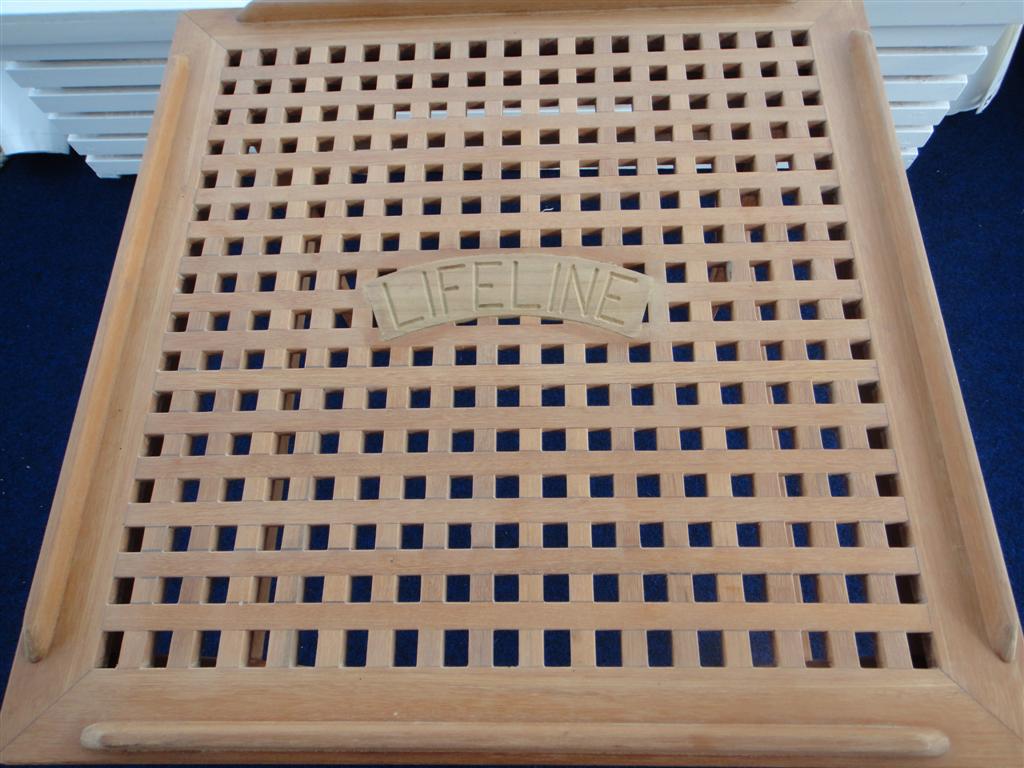
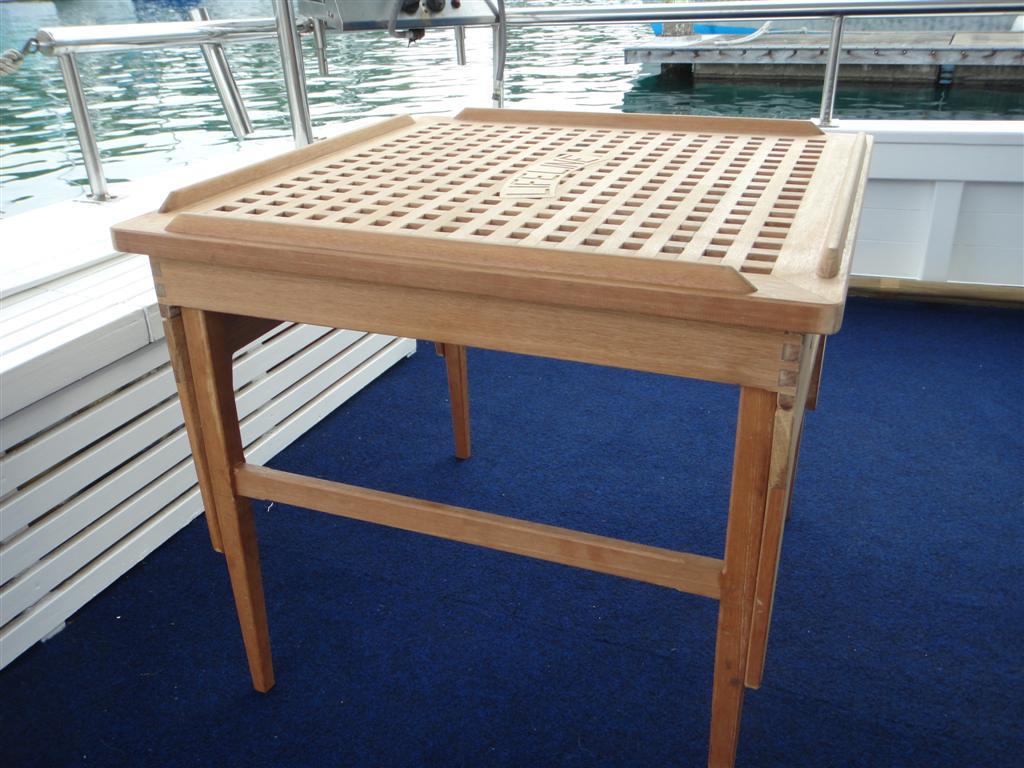
Juhan insisted they had to fold up (even though I didn’t care) and invented a concealed hinge system that intrigues all those with an interest in carpentry.
Another lucky find for me was John on MV Solita, a diesel engineer who used to manage a fleet of commercial boats, some with Gardner diesels.
(Remember MV Solita in our 2004 Cruising Log? Philip and I helped deliver her from Cairns to Darwin in 2004). John and Sue bought Solita in 2008(?) and cruised to Southeast Asia where I caught up with them in Kota Kinabalu. John now runs a sort of mobile diesel service as Solita cruises the Philippines and Borneo.
Lifeline’s diesel, being a Gardner, is pretty bullet proof. One of the things that attracted Philip to Lifeline in the first place was getting a simple, slow revving, unsophisticated Gardner diesel that he could understand and service himself. But, even though I have the manuals and sorta/kinda know my way around the engineroom, I didn’t relish having to learn how to actually do anything down there!! But learn I had to....and the gradient of the curve was steep.
One of my early jobs after Philip died was to try to work out how the fuel system worked. With four 750 litre storage tanks and a 400 litre day tank, flow lines, return lines, an inline fuel pump and 15 valves(!) it was a challenge. I crawled around the engine room and tank room, following the lines and finally came up with a colour coded diagram with numbered valves (and it actually works!).
.jpg)
John was the one who told me he could easily instal a fuel polishing set up into my fuel system. So, of course, I jumped at the chance. (It meant modifying my beautiful diagram but - what the heck!) Since then he has serviced the engine and shaft bearings etc yearly, including servicing the injectors, replacing a cracked exhaust elbow, taking out and cleaning the cooling system and replacing the thermostats, replacing filters, seals and belts, making sure I have a full set of spares and, best of all for me, setting up an easy engine management system. Always the professional, John wrote me an engineroom management plan with all the milestones that need to be covered. And best of all he even painted the engine fluid fillers and dipsticks red so I can find them easily.
He also writes me a report on work completed, often with photographs.
Lifeline was always a working boat - even when we were cruising. Philip did everything to ensure the boat was safe and strong and we always slipped yearly but Lifeline was always too busy for extra TLC. But since Lifeline has been staying in one place with access to experts at affordable cost, it's been a lot easier for me have projects done as I think of them. I am hopeful that Philip would approve.
.....That doesn’t include electronics unfortunately. First it was the hard working Latronics inverter, which needed a new motherboard. Next it was the built-in Furuno GPS interfaced with the laptop for navigation. As I have multiple back up GPSs I haven’t worried about that one. But then last year it was the tacho - and I had to source the part from Australia and pick it up last time I was there. Since then the magnetron has gone on the Furuno radar - the receiver works like a beauty - but it just doesn’t pick up anything. And now the back speakers in the cockpit don’t work. AARRRRGGGGGHHHHHH!
I picked up the latest Whitworths catalogue in Australia last time and I know I can replace the GPS with almost the exact same Furuno model for $600 and a comparable Furuno standalone radar for $2,000. (UPDATE!! I bit the bullet and bought the new radar. It's been installed by the local Furuno guy and all hunky dory.) I must say I do like having radar, but for once a year going to and from the slip? It does seem a bit of an extravagance. On the other hand my aim is to keep Lifeline in full working/cruising order....what to do?
As everyone says, the boat task list never gets any shorter. I used to keep thinking “this time it’ll all be finished” - but now I’ve learnt that’s not in the nature of boats.
Looking back over this post, it seems there is a lot of boat maintenance. But that’s really just for your benefit because I thought that would be more interesting to you than my "no-longer-cruising" life. My only role now in Lifeline’s maintenance (apart from the monthly putting water in the batteries and firing up the engine from time to time) is to make lists of jobs for someone else to do.
One thing I'm proud that I DID do, mainly to help myself understand Lifeline’s systems, is write a user manual called “Lifeline for Dummies”. I wrote down everything I could to help myself remember how to operate all the systems on the boat. It's proved invaluable not just to me but to others who need to know what's what when I'm not there.
But the rest of the time what I do is swan around all day swimming laps in Sutera's olympic pool, eating, shopping, more eating, having my hair done and volunteering at a small local school a few days a week. I am still trying to learn Malaysian, despite proving to be an abject dunce at it. Have I mentioned I love eating Malaysian food?
I am a member of one of the local Toastmasters clubs and I go to the Sabah Society once or twice a month to learn about my new home. As I have to leave the country every 90 days to renew my Malaysian visa, I travel quite a bit now by plane. That includes a couple of trips a year back to Australia where I have now finished building a small cottage on an island in Moreton Bay.
OK. Enough of an update I think.